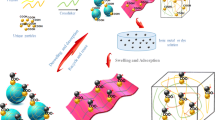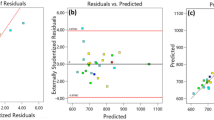Abstract
The chitosan/polypyrrole (Ks/PPy) nanoparticle composite was synthesized using chitosan (Ks) and pyrrole (PPy) and embedded in a cross-linked poly(acrylamide) (PAAm) hydrogel polymer matrix. Poly(acrylamide) embedded chitosan/polypyrrole (PAAm-Ks/PPy) hydrogels were treated with a hydrochloric acid (HCl) solution, and the poly(acrylamide)-chitosan/polypyrrole-HCl (PAAm-Ks/PPy-H) hydrogels were prepared. The synthesized Ks/PPy nanoparticles were characterized by Fourier transform infrared (FT-IR) spectroscopy, thermal gravimetric (TG) analysis, scanning electron microscope (SEM), particle size analysis (Mastersizer), and 4-point electrical conductivity measurements. The size of the synthesized Ks/PPy nanoparticles composite was measured as Dv(90) = 114 nm. The size of the majority of Ks/PPy nanoparticle was observed at approximately 100 nm according to their SEM images. The electrical conductivity of the Ks/PPy nanoparticles was measured as 5.79E–1 mS cm−1, and this value is approximately 261,000 times higher than the electrical conductivity of Ks biopolymer. Also, the electrical conductivity of chitosan/polypyrrole treated with HCl (Ks/PPy-H) nanoparticles was measured as 2.53 mS cm−1. The electrical conductivity of Ks/PPy-H nanoparticles increased approximately 4.4 times compared to Ks/PPy nanoparticles after HCl treatment. PAAm-Ks/PPy hydrogel was characterized with the FT-IR, TG, SEM, and 4-point electrical conductivity measurements. The percent of swelling (S%) value of composite P(AAm)-Ks/PPy and P(AAm)-Ks/PPy-H hydrogels was determined as approximately 1949 and 2001%, respectively. The S% values of these hydrogels are about 15% higher than the PAAm hydrogel. Among the synthesized hydrogels, the swelled PAAm-Ks/PPy-H hydrogel has the highest electrical conductivity value with 2.0E−5 ± 8.7E−6 mS cm−1. The adsorption performance of the synthesized hydrogels was investigated for methyl orange from the aqueous solution. It is determined that the adsorption performance of the PAAm-Ks/PPy-H hydrogel is approximately fourfold and 20-fold higher than the PAAm-Ks/PPy and the PAAm hydrogel, respectively.
Graphical abstract








Similar content being viewed by others
References
Ahmed EM (2015) Hydrogel: preparation, characterization, and applications: a review. J Adv Res 6:105–121. https://doi.org/10.1016/j.jare.2013.07.006
Mahinroosta M, Jomeh Farsangi Z, Allahverdi A, Shakoori Z (2018) Hydrogels as intelligent materials: a brief review of synthesis, properties and applications. Mater Today Chem 8:42–55. https://doi.org/10.1016/j.mtchem.2018.02.004
Koetting MC, Peters JT, Steichen SD, Peppas NA (2015) Stimulus-responsive hydrogels: theory, modern advances, and applications. Mater Sci Eng R Rep 93:1–49. https://doi.org/10.1016/j.mser.2015.04.001
Mohammadzadeh Pakdel P, Peighambardoust SJ (2018) Review on recent progress in chitosan-based hydrogels for wastewater treatment application. Carbohydr Polym 201:264–279. https://doi.org/10.1016/j.carbpol.2018.08.070
Li S, Dong S, Xu W et al (2018) Antibacterial hydrogels. Adv Sci. https://doi.org/10.1002/advs.201700527
Guo Y, Bae J, Fang Z et al (2020) Hydrogels and hydrogel-derived materials for energy and water sustainability. Chem Rev 120:7642–7707. https://doi.org/10.1021/acs.chemrev.0c00345
Hamedi H, Moradi S, Hudson SM, Tonelli AE (2018) Chitosan based hydrogels and their applications for drug delivery in wound dressings: a review. Carbohydr Polym 199:445–460. https://doi.org/10.1016/j.carbpol.2018.06.114
Liu X, Liu J, Lin S, Zhao X (2020) Hydrogel machines. Mater Today 36:102–124. https://doi.org/10.1016/j.mattod.2019.12.026
Alpaslan D, Ersen Dudu T, Aktas N (2021) Synthesis of smart food packaging from poly(gelatin-co-dimethyl acrylamide)/citric acid-red apple peel extract. Soft Mater 19:64–77. https://doi.org/10.1080/1539445X.2020.1765802
Rinaudo M (2006) Chitin and chitosan: properties and applications. Prog Polym Sci 31:603–632. https://doi.org/10.1016/j.progpolymsci.2006.06.001
Khor E, Lim LY (2003) Implantable applications of chitin and chitosan. Biomaterials 24:2339–2349. https://doi.org/10.1016/S0142-9612(03)00026-7
Mathur NK, Narang CK (1990) Chitin and chitosan, versatile polysaccharides from marine animals. J Chem Educ 67:938–942. https://doi.org/10.1021/ed067p938
Younes I, Rinaudo M (2015) Chitin and chitosan preparation from marine sources. Structure, properties and applications. Mar Drugs 13:1133–1174. https://doi.org/10.3390/md13031133
Prashanth KVH, Kittur FS, Tharanathan RN (2002) Solid state structure of chitosan prepared under different N-deacetylating conditions. Carbohydr Polym 50:27–33
Muzzarelli RAA (2009) Chitins and chitosans for the repair of wounded skin, nerve, cartilage and bone. Carbohydr Polym 76:167–182. https://doi.org/10.1016/j.carbpol.2008.11.002
Agnihotri SA, Mallikarjuna NN, Aminabhavi TM (2004) Recent advances on chitosan-based micro- and nanoparticles in drug delivery. J Control Release 100:5–28. https://doi.org/10.1016/j.jconrel.2004.08.010
Anitha A, Sowmya S, Kumar PTS et al (2014) Chitin and chitosan in selected biomedical applications. Prog Polym Sci 39:1644–1667. https://doi.org/10.1016/j.progpolymsci.2014.02.008
Elsabee MZ, Abdou ES (2013) Chitosan based edible films and coatings: a review. Mater Sci Eng C 33:1819–1841. https://doi.org/10.1016/j.msec.2013.01.010
Baldrick P (2010) The safety of chitosan as a pharmaceutical excipient. Regul Toxicol Pharmacol 56:290–299. https://doi.org/10.1016/j.yrtph.2009.09.015
Suginta W, Khunkaewla P, Schulte A (2013) Electrochemical biosensor applications of polysaccharides chitin and chitosan. Chem Rev 113:5458–5479
Baniasadi H, Ahmad Ramazani SA, Mashayekhan S (2015) Fabrication and characterization of conductive chitosan/gelatin-based scaffolds for nerve tissue engineering. Int J Biol Macromol 74:360–366. https://doi.org/10.1016/j.ijbiomac.2014.12.014
Ma L, Zhou X, Xu L et al (2015) Electrochimica acta chitosan-assisted fabrication of ultrathin MoS2/graphene heterostructures for Li-ion battery with excellent electrochemical performance. Electrochim Acta 167:39–47. https://doi.org/10.1016/j.electacta.2015.03.129
Gupta VK (2009) Application of low-cost adsorbents for dye removal: a review. J Environ Manag 90:2313–2342. https://doi.org/10.1016/j.jenvman.2008.11.017
Bai H, Shi G (2007) Chemiresistive gas sensors based on conducting polymers. Sensors 7:267–307. https://doi.org/10.4018/978-1-5225-1798-6.ch022
Kaur G, Adhikari R, Cass P et al (2015) Electrically conductive polymers and composites for biomedical applications. RSC Adv 5:37553–37567. https://doi.org/10.1039/c5ra01851j
Sajesh KM, Jayakumar R, Nair SV, Chennazhi KP (2013) Biocompatible conducting chitosan/polypyrrole-alginate composite scaffold for bone tissue engineering. Int J Biol Macromol 62:465–471. https://doi.org/10.1016/j.ijbiomac.2013.09.028
Karthik R, Meenakshi S (2015) Removal of hexavalent chromium ions from aqueous solution using chitosan/polypyrrole composite. Desalin Water Treat 56:1587–1600. https://doi.org/10.1080/19443994.2014.951964
Alsaiari NS, Amari A, Katubi KM et al (2021) Innovative magnetite based polymeric nanocomposite for simultaneous removal of methyl orange and hexavalent chromium from water. Processes. https://doi.org/10.3390/pr9040576
Zhang Y, Xue Q, Li F, Dai J (2019) Removal of heavy metal ions from wastewater by capacitive deionization using polypyrrole/chitosan composite electrode. Adsorpt Sci Technol 37:205–216. https://doi.org/10.1177/0263617418822225
Mashkoor F, Nasar A (2020) Facile synthesis of polypyrrole decorated chitosan-based magsorbent: characterizations, performance, and applications in removing cationic and anionic dyes from aqueous medium. Int J Biol Macromol 161:88–100. https://doi.org/10.1016/j.ijbiomac.2020.06.015
Tahir N, Bhatti HN, Iqbal M, Noreen S (2017) Biopolymers composites with peanut hull waste biomass and application for crystal violet adsorption. Int J Biol Macromol 94:210–220. https://doi.org/10.1016/j.ijbiomac.2016.10.013
Liu XQ, Zhao XX, Liu Y, Zhang TA (2022) Review on preparation and adsorption properties of chitosan and chitosan composites. Springer, Berlin
Yang J, Chen X, Zhang J et al (2021) Role of chitosan-based hydrogels in pollutants adsorption and freshwater harvesting: a critical review. Int J Biol Macromol 189:53–64. https://doi.org/10.1016/j.ijbiomac.2021.08.047
Zhu H, Chen S, Luo Y (2023) Adsorption mechanisms of hydrogels for heavy metal and organic dyes removal: a short review. J Agric Food Res 12:100552. https://doi.org/10.1016/j.jafr.2023.100552
Shannon MA, Bohn PW, Elimelech M et al (2008) Science and technology for water purification in the coming decades. Nature 452:301–310. https://doi.org/10.1038/nature06599
Trenberth KE, Dai A, van der Schrier G et al (2014) Global warming and changes in drought. Nat Clim Chang 4:17–22. https://doi.org/10.1038/nclimate2067
Akharame MO, Fatoki OS, Opeolu BO (2019) Regeneration and reuse of polymeric nanocomposites in wastewater remediation: the future of economic water management. Springer, Berlin
Handy RD, Owen R, Valsami-Jones E (2008) The ecotoxicology of nanoparticles and nanomaterials: current status, knowledge gaps, challenges, and future needs. Ecotoxicology 17:315–325. https://doi.org/10.1007/s10646-008-0206-0
Haque E, Jun JW, Jhung SH (2011) Adsorptive removal of methyl orange and methylene blue from aqueous solution with a metal-organic framework material, iron terephthalate (MOF-235). J Hazard Mater 185:507–511. https://doi.org/10.1016/j.jhazmat.2010.09.035
Mohammadi N, Khani H, Gupta VK et al (2011) Adsorption process of methyl orange dye onto mesoporous carbon material-kinetic and thermodynamic studies. J Colloid Interface Sci 362:457–462. https://doi.org/10.1016/j.jcis.2011.06.067
Robati D, Mirza B, Rajabi M et al (2016) Removal of hazardous dyes-BR 12 and methyl orange using graphene oxide as an adsorbent from aqueous phase. Chem Eng J 284:687–697. https://doi.org/10.1016/j.cej.2015.08.131
Ma J, Yu F, Zhou L et al (2012) Enhanced adsorptive removal of methyl orange and methylene blue from aqueous solution by alkali-activated multiwalled carbon nanotubes. ACS Appl Mater Interfaces 4:5749–5760. https://doi.org/10.1021/am301053m
Fan J, Guo Y, Wang J, Fan M (2009) Rapid decolorization of azo dye methyl orange in aqueous solution by nanoscale zerovalent iron particles. J Hazard Mater 166:904–910. https://doi.org/10.1016/j.jhazmat.2008.11.091
Rocher V, Siaugue JM, Cabuil V, Bee A (2008) Removal of organic dyes by magnetic alginate beads. Water Res 42:1290–1298. https://doi.org/10.1016/j.watres.2007.09.024
Bayazit ŞS (2014) Magnetic multi-wall carbon nanotubes for methyl orange removal from aqueous solutions: equilibrium, kinetic and thermodynamic studies. Sep Sci Technol 49:1389–1400. https://doi.org/10.1080/01496395.2013.879595
Wong KT, Wong VL, Lim SS (2021) Bio-sorptive removal of methyl orange by micro-grooved chitosan (GCS) beads: optimization of process variables using Taguchi L9 orthogonal array. J Polym Environ 29:271–290. https://doi.org/10.1007/s10924-020-01878-6
Wang W, Zhang H, Shen J, Ye M (2018) Facile preparation of magnetic chitosan/poly (vinyl alcohol) hydrogel beads with excellent adsorption ability via freezing-thawing method. Colloids Surfaces A Physicochem Eng Asp 553:672–680. https://doi.org/10.1016/j.colsurfa.2018.05.094
Zeng L, Xie M, Zhang Q et al (2015) Chitosan/organic rectorite composite for the magnetic uptake of methylene blue and methyl orange. Carbohydr Polym 123:89–98. https://doi.org/10.1016/j.carbpol.2015.01.021
Sui K, Li Y, Liu R et al (2012) Biocomposite fiber of calcium alginate/multi-walled carbon nanotubes with enhanced adsorption properties for ionic dyes. Carbohydr Polym 90:399–406. https://doi.org/10.1016/j.carbpol.2012.05.057
Acknowledgements
The authors thank Çanakkale Onsekiz Mart University Scientific Research Project Commission for support with the Project Number FBA-2019-2870.
Author information
Authors and Affiliations
Corresponding author
Ethics declarations
Conflict of interest
All authors declare that they have no conflict of interest.
Additional information
Publisher's Note
Springer Nature remains neutral with regard to jurisdictional claims in published maps and institutional affiliations.
Rights and permissions
Springer Nature or its licensor (e.g. a society or other partner) holds exclusive rights to this article under a publishing agreement with the author(s) or other rightsholder(s); author self-archiving of the accepted manuscript version of this article is solely governed by the terms of such publishing agreement and applicable law.
About this article
Cite this article
Yaşar, A.Ö., Kaya, İ. The preparation and characterization of poly(acrylamide) hydrogel embedded chitosan/polypyrrole nanoparticle for methyl orange removal. Polym. Bull. 81, 4237–4255 (2024). https://doi.org/10.1007/s00289-023-04902-6
Received:
Revised:
Accepted:
Published:
Issue Date:
DOI: https://doi.org/10.1007/s00289-023-04902-6




